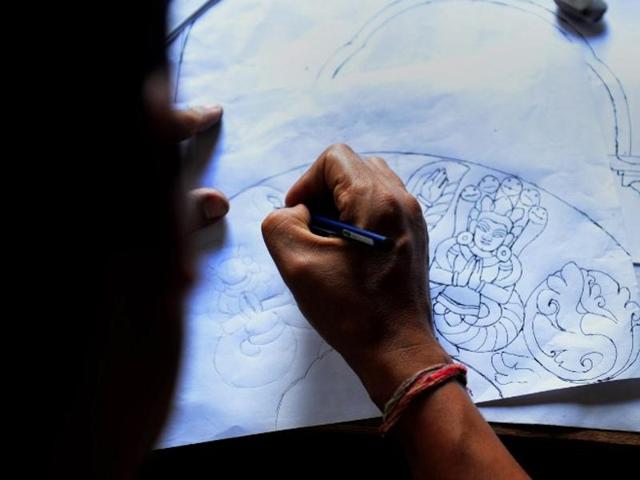Post-quake Nepal struggles to preserve vanishing skills
In a dusty studio, Indra Kaji Shilpakar painstakingly carves intricate patterns into a wooden panel, one of a small group of highly-skilled craftsmen Nepal is relying on to rebuild its cultural heritage after April’s major earthquake.

But Shilpakar, a master craftsman who learned at the hands of his father and uncle as a young boy, is one of a dying breed.
The wood-carvers, stone-sculptors and metal-workers who created the spectacular temples and palaces of the Kathmandu Valley were once feted as far away as China, and paid handsomely from the royal purse.
But over the decades their social status has fallen along with the money they are able to earn from their craft, and many young Nepalis are now rejecting the family trade to seek better paid work.
That has left the country short of skills crucial for rebuilding the centuries-old monuments of the Kathmandu Valley lost in the April 25 quake.
It is a problem made worse by the fact that these crafts have historically been the exclusive and jealously guarded preserve of a few families belonging to the Newar ethnic group indigenous to the Valley.
Shilpakar, a slight, softly-spoken man of 52, says all his male relatives as far back as anyone can remember have worked with wood, producing the intricately carved panels that grace Nepal’s temples and traditional homes.
“But many in the new generation want different jobs, office jobs,” he told AFP in his studio in the historic city of Bhaktapur, where he is working on the restoration of a classic three-tiered wooden pagoda temple from the 17th century.

“Even in my own family, there are people who have not continued with the work that requires a high level of skill, because it doesn’t pay,” said Shilpakar, whose uncle’s family has moved to the more lucrative furniture business.
“There isn’t much respect in Nepal -- we are considered as workers, not artists.”
Ancient kingdoms
That is not the view of the UN cultural agency UNESCO, which describes the stone, timber and bronze craftsmanship of the Newars as among the most highly-developed in the world.
Many of the palaces and temples they created date back to the period between the 12th and 18th centuries when the Valley -- a World Heritage site -- was divided into the three kingdoms of Kathmandu, Patan and Bhaktapur.
Eager to lure back tourists, the government reopened the former Durbar (Royal) Squares of all three cities in June, despite warnings from UNESCO that this could cause further damage to the monuments.
They are home to some of the thousands of monuments damaged in the 7.8-magnitude quake, which killed nearly 9,000 people and destroyed around half a million homes.
The mammoth task of rebuilding has been delayed by the monsoon rains and by a political crisis that has held up a $4.1 billion reconstruction fund.
When it does rebuild, UNESCO heritage expert Kai Weise believes a shortage of skilled craftsmen will be one of the key impediments.
“We are trying to get the government to acknowledge the importance of artisans and set up some kind of system,” he said.
“We need to find the master craftspersons and get them to train new artisans.”
Hereditary system ‘not practical’
The Kathmandu Valley Preservation Trust, a charity set up in 1991, also wants Nepal to set up a formal training system to preserve its unique skills.
“Generation to generation is not practical,” Nepal country director Rohit Ranjitkar told AFP.
“If someone is interested in learning, they should be given the opportunity. There should be a professional school for this kind of work.”
Conservationists are optimistic that at least some of the monuments can be restored, as happened after the last major quake that hit the Valley in 1934.
They are not just tourist attractions -- despite the rapid urbanisation of Kathmandu, the three Durbar Squares remain at the heart of local cultural and spiritual life.
But it is not difficult to see why young Nepalis are turning away from their family traditions.
While the monarchs who funded this flourishing of art and architecture are celebrated with statues, the artists themselves have received little recognition in Nepal, whose last king left the throne in 2008.
Nonetheless Indra Kaji Shilpakar is determined to do all he can to help the country rebuild its architectural treasures.
“You feel pride when you look at a temple you have worked on. There’s a satisfaction in doing something for your country,” he said.
But he admits he can earn more than twice as much carving crude wooden Buddha heads for shops to sell to tourists, and wants his sons to choose a different life.
UNESCO’s Weise believes this lack of recognition must be addressed if Nepal is to rebuild.
“We are talking about millions of dollars, but without artisans we can’t rebuild anything,” he said.



